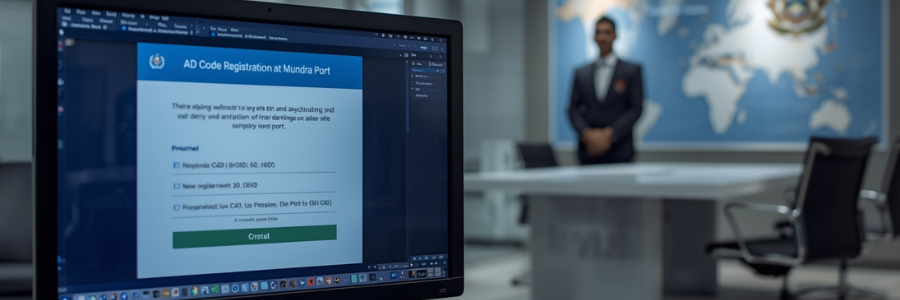A Step-by-Step Guide to AD Code Registration at Mundra Port
Introduction
The designated ports in India are the primary gateway for exporters and importers. By overtaking all recognized ports, the ‘Mundra Port,’ which is owned by the Adani Group, has taken first place in India. Its growing popularity is attracting new export and import houses. However, here’s the catch: Before starting to ship the goods or services from Mundra Port, the businesses are first required to obtain a valid AD code. AD Code registration at Mundra Port is a prerequisite to gaining customs clearance. Let’s explore the page to know more about how exporters can apply for the AD code at Adani-owned ports, its benefits, and much more. Let’s take a closer look at the page.
1. Mundra Port: A Complete Overview
The ‘Mundra Port’ was established in 1998, and the company is under the Adani Group. Currently, it is operated by the Adani Ports & SEZ Limited (APSEZ). The port is also marked as the Indian special economic zone. In addition, as the largest container port in India, it gained worldwide recognition despite being the first private port. Adani Group’s first port is located in the Kutch District of Gujarat, which is near the Gulf of Kutch. Furthermore, in recent times, it has constituted nearly 11% of India’s maritime cargo.
1.1 The Mundra Port Connectivity Via Multiple Transportations
Adani’s Port provides various inland connectivity. It encompasses the rail route to the roadways, airport, and cross-border pipelines. This can be understood as
Rail Connectivity: The Indian Railway network is linked with Mundra Port Ltd. In the current time, its line is spread from Mundra to Adipur.
Road Connectivity: The road connectivity of Mundra Port is via National Highway 8A Extn. & State Highways 6 & 48.
Air Connectivity: Mundra Airport comes under the ‘private category.’ It is managed by the Airports Authority of India.
2. What is the significance of Mundra Port in international trade?
Adani Group’s Mundra Port plays a crucial role in international trade markets. As India’s largest commercial port, it has become the gateway for exporters and importers. Its features, such as state-of-the-art, multi-model connectivity and deeper draft capacity, make it the most capable for cargo. The major Adani Group port significances are:
I) Largest Commercial Port in India
By the cargo volume, Mundra Port is tagged as India’s largest private commercial port. It operates under Adani Ports and Special Economic Zone (APSEZ). The major things it manages are maritime cargo and container traffic. The port majority is divided as one-fourth of the nation’s total cargo and one-third of its container traffic.
II) Strategic Locations
Due to its location in Gujarat’s Gulf of Kutch, it offers easy and cost-effective access to India’s vast northern and north-western hinterlands. Major international shipping lanes are located on the western coastline.
III) Best Quality Infrastructure
Mundra Port’s standard infrastructure involves:
- The high volume for multiple container terminals.
- One of the largest mechanized coal import terminals in the world.
- Active for liquid cargo berths with large tank farms.
- For the vehicle export, the Roll-On/Roll-Off terminals
IV) Integrated Special Economic Zone (SEZ)
The port offers the service for multiple products in a port-based SEZ. Furthermore, the port offers a duty-free industrial zone for trade and manufacturing.
3. What is the Role of Mundra Port for Exporters?
Due to the strategic location and state-of-the-art infrastructure, the Mundra Port has become the most selected location for goods export. For the exporters, it serves as the gateway to offer global market access. It offers excellent access to major trade routes. Another reason why it is the most catchy destination is the multi-modal connectivity and export benefits like duty exemptions. The export route is connected to the direct national railway grid and major national highways. In addition, the exporters can get multiple advantages, such as cost savings through customs duty exemptions, excise duty, and other state levies. However, to connect with this port and the various benefits offered, the exporters first need to get the AD code.
4. Importance of AD Code Registration at Mundra Port
Like the other ports, the registration of the AD code for Mundra Port is also compulsory. Through the Authorized Dealer (AD) code registration, the exporter gains customs clearance access, which allows them to file shipping bills, etc. In addition, with the AD code, the exporter-importer can verify their banking details for foreign exchange transactions. AD code registration is important because:
- Requirement for Customs Clearance: The customs authority at Mundra Port asks exporters to first file the shipping bill. However, to file it, the exporters first need the AD code to navigate the ICEGATE platform requirements. It is important to submit a shipping bill in order to receive approval from Customs.
- Foreign Exchange Flow Tracking: With the registration of the AD code at Customs, the RBI will track the flow of foreign exchange transactions. This measure is in place to verify that the exporter is receiving foreign currency from authorized and legitimate sources; exportation does not occur through illegal exchanges.
- Government Export Benefits: The AD code is mainly used to link the business bank account to customs, which is how exporters can avail of incentives and government schemes the exporter is entitled to, such as duty drawback and IGST refunds.
- Comply with Regulatory Requirements: Authorized dealer regulatory code registration is an additional essential step to comply with RBI and FEMA guidelines and practices. The customs authority gets access to monitor foreign exchange inflow and outflow.
- Port-Wise Registration: If an exporter is thinking of exporting goods from Mundra Port, they must register their AD code at that port.
5. Key criteria and documentation needed for AD Code registration
To be eligible for an AD (Authorized Dealer) code, the exporters-importers are required to fulfill the RBI and FEMA’s set guidelines.
The Eligibility Requirements:
For AD code registration at Mundra Port, the exporter must have a valid and active Import-Export Code (IEC). The exporter’s bank must be open in the RBI’s authorized bank, which deals in foreign exchange. Lastly, Class 3 DSC is mandatory for online registration on the ICEGATE portal.
Required Documents for Mundra Port AD Code:
- Must obtain the 14-digit character AD code letter from RBI’s authorized bank.
- Copy of the IEC number, issued by the DGFT (Directorate General of Foreign Trade).
- Applicant’s registered GSTIM certificate.
- The company’s PAN (Permanent Account Number) copy.
- A cancelled cheque from the business bank account is a permanent bank detail verification.
- The letter of authority is sent from the company exporter to the bank requesting AD code authorization.
- Identity and address proof for the authorized signatory.
6. Sum Up | AD Code Registration Process at Mundra Port
AD (Authorized Dealer) code registration at Mundra Port smooths the international trade activities. It makes the customs clearance faster, manages the foreign currency payments, and allows for claiming government export activities. As AD codes are given dynamic validity, exporters and importers can allocate their resources toward business growth and developing new products for international markets. The registration through Mundra Port allows exporters and importers to further establish credibility by showing they are legitimate businesses. For the faster and streamlined AD code application for Mundra Port, visit the LegalRaasta.com website.
Don’t miss this related guide: AD Code Validity: Do You Ever Need to Renew Your Registration?
7. Customs Clearance at Mundra Port: Frequently Asked Questions
1. Where is Mundra Port located?
Ans. India’s first private commercial port, Mundra Port, is located near Mundra, in the Kutch district of Gujarat.
2. Why is the AD code at Mundra Port important?
Ans. For customs clearance, generating the shipping bill, and direct export government support benefits, the registration of the AD code at Mundra Port is vital.
3. Who cannot register at Mundra Port?
Ans. Since 2021, a few countries, such as Iran, Pakistan, and Afghanistan, have not been registered at Mundra Port and other Adani Ports. These countries’ containerized cargoes are banned from all of Adani’s ports.
4. What is the cost of AD code registration at Mundra Port?
Ans. There is not a single registration fee, but it is divided into multiple stages. It includes ICEGATR one-time registration for customs clearance, which is Rs 2,999. The cost includes the Import-Export Code (IEC) and DSC (Digital Signature Requirement).
5. Who authorizes banks to issue AD code letters?
Ans. RBI (Reserve Bank of India) is responsible for issuing the AD code letter to exporters and importers who wish to trade internationally.










